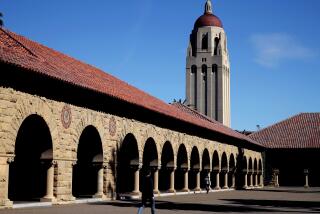Study touts CalPERS’ benefit to economy
- Share via
Investments by the California Public Employees’ Retirement System, the nation’s largest public pension fund, spurred $15.1 billion in economic activity in California in 2006, creating more than 124,000 jobs, a new study found.
The study, to be released today at a California pension fund conference in Los Angeles, found that the $247-billion fund created more economic activity last year than industries including machinery manufacturing, oil and gas extraction, and amusements, gambling and recreation. It also created more jobs than the heavy and civil engineering construction industry, and the motion picture and video production industry, the study said.
According to the report by researchers at Cal State Sacramento, CalPERS directly invested $8.3 billion in the state economy in 2006. That translated to $15.1 billion in total activity as the investment “rippled” through the marketplace, the report said.
More than half of the fund’s direct investment was in private real estate development, 29% was in stocks and 11% in construction-related partnerships, the report said. Los Angeles got the biggest piece of the investment pie, $2.2 billion.
CalPERS “has made some very, very strategic investments,” especially in L.A. real estate, said Jack Kyser, chief economist for the Los Angeles County Economic Development Corp. “When CalPERS comes into a project, it’s like a Good Housekeeping seal of approval because they do not throw their money around.”
CalPERS money has backed projects including the Hollywood & Highland center that houses the Kodak Theatre; a development that brought a Ralphs supermarket to downtown L.A.; and the Ladera Center, a neighborhood shopping mall.
CalPERS commissioned the university’s economic impact study, the fund’s first, partially to counter criticism that its defined-benefit pensions, with fixed payments, are becoming a burden on deficit-plagued state and local governments, which participate in the CalPERS system. Critics fear that taxpayers could be forced to pay pension obligations if CalPERS doesn’t earn enough on its investments.
CalPERS, however, counters that it has a strong investment history with a portfolio that has grown an average of 9.1% annually in the last decade.
In 2005, Gov. Arnold Schwarzenegger led an unsuccessful initiative campaign that would have denied fixed monthly pension checks to new state workers and instead have them participate in 401(k)-type investment plans used by private employers.
“We wanted to generate broad understanding of all the ways the pension system helps our members, directly or indirectly,” said CalPERS spokeswoman Patricia Macht. CalPERS has 1.5 million members and more than 400,000 retirees. But some skeptics say they still believe the system needs to be changed.
“It’s a complete falsehood to look at the situation the way CalPERS is looking at it,” said Keith Richman, a former state Assembly member who now heads a large medical care provider network in Glendale.
For instance, he suggested that if CalPERS did not have to pay out as much in pension benefits, the state could spend more money on things such as improving higher education.
“To think that the money going into pension benefits or the pension system could not be used in other economic activities is just false,” Richman said.
CalPERS is considering new public-sector investments, including helping to rebuild California’s crumbling roads, bridges and other public works, Macht said.
“They have the power to focus their investments to bring social and economic benefits to California,” said Stephen Levy, an economist and director of the Center for the Continuing Study of the California Economy in Palo Alto.
“What makes it unique as a larger investor is they can combine their portfolio standards -- making money for the retirees -- and help the state as a whole.”
--
(BEGIN TEXT OF INFOBOX)
Influential investor
The $247-billion California Public Employees’ Retirement System has a big effect on California’s economy. A new study found that CalPERS investments last year directly and indirectly generated more economic activity and jobs than many industries. A look at their comparative strengths:
Direct investment, 2006
CalPERS…$8.5 billion
Oil and gas extraction…$7.7 billion
Machinery manufacturing…$7.5 billion
Amusements, gambling and recreation…$7.5 billion
Plastics manufacturing…$4.7 billion
--
Job creation, 2006
CalPERS investment…124,377
Motion picture and video production…115,000
Heavy and civil engineering construction…92,900
Chemical manufacturing…85,000
Semiconductor manufacturing…61,800
--
Sources: CalPERS, Applied Research Center at Cal State Sacramento
More to Read
Inside the business of entertainment
The Wide Shot brings you news, analysis and insights on everything from streaming wars to production — and what it all means for the future.
You may occasionally receive promotional content from the Los Angeles Times.











